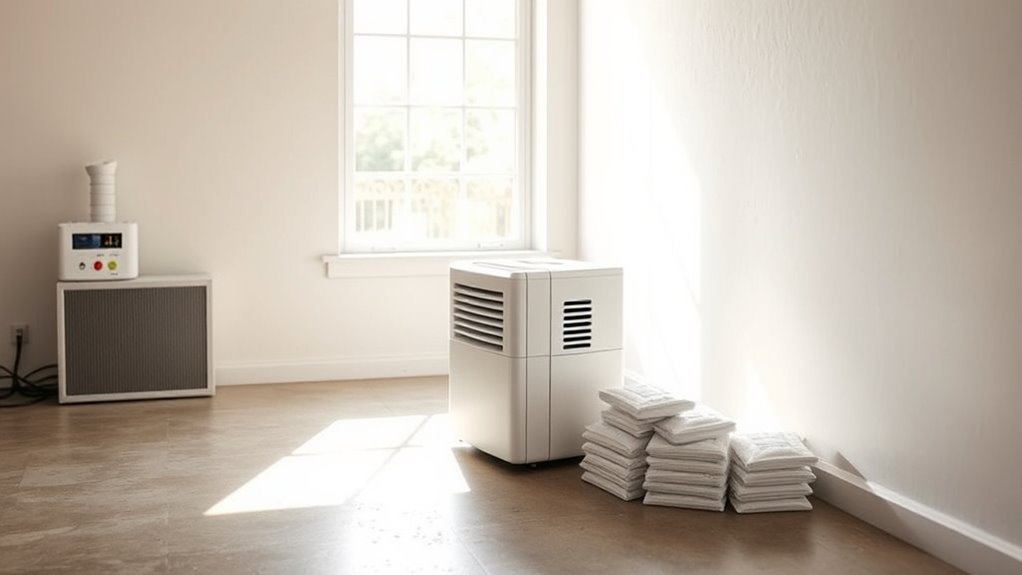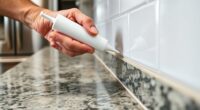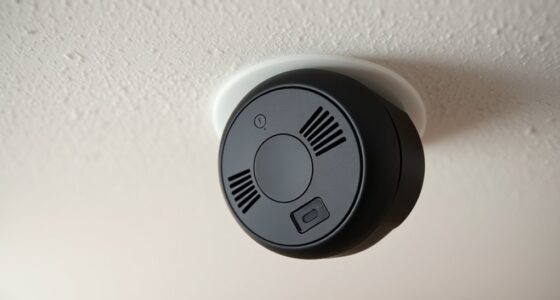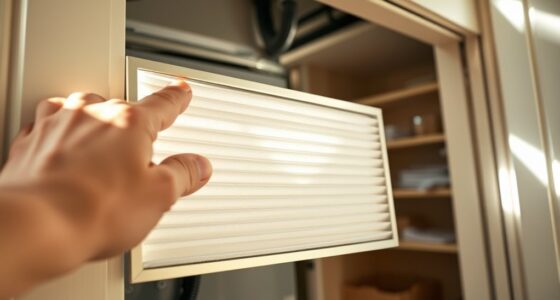To stop mold before it starts, keep humidity levels between 30-50% by using exhaust fans in bathrooms and kitchens, and running a dehumidifier. Fix leaks immediately and check for water stains or damp spots often. Ascertain proper ventilation by opening windows when possible and maintaining good insulation to reduce condensation. Regularly clean surfaces and use mold-resistant paints in moisture-prone areas. Continuing will reveal simple tips to master moisture control effortlessly.
Key Takeaways
- Use exhaust fans during cooking, showering, and laundry to remove excess humidity at the source.
- Maintain indoor humidity levels between 30%-50% with dehumidifiers and proper ventilation.
- Regularly inspect and promptly repair leaks in pipes, roofs, and windows to prevent moisture entry.
- Improve insulation and install vapor barriers to reduce condensation and moisture migration inside walls and floors.
- Keep surfaces dry, use mold-resistant paints, and ensure good air circulation to create an environment inhospitable to mold growth.
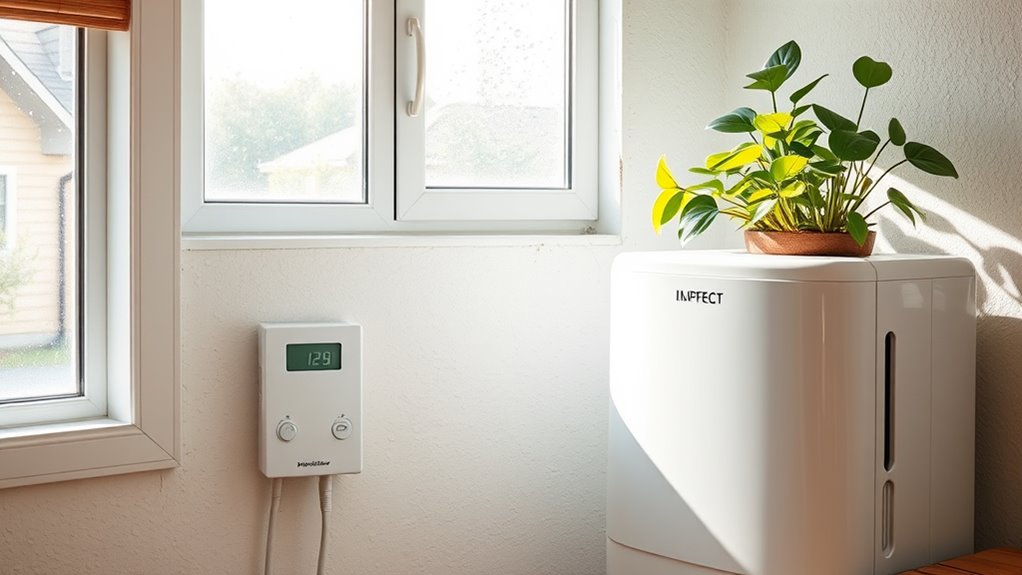
Have you ever wondered how moisture affects your home and health? It’s a sneaky problem that can cause a lot of trouble if you’re not paying close attention. Moisture isn’t always obvious, but it quietly seeps into your walls, ceilings, and floors, creating the perfect environment for mold to grow. Mold isn’t just an unsightly stain; it can trigger allergies, asthma, and other respiratory issues. That’s why understanding how to control moisture is key to maintaining a healthy home and avoiding costly repairs down the line.
Moisture can secretly damage your home and health if left unchecked.
First, recognize the common sources of excess moisture. Daily activities like cooking, showering, and doing laundry release a lot of humidity into the air. Without proper ventilation, this moisture can accumulate and settle into surfaces. Poorly ventilated bathrooms and kitchens are particularly vulnerable. Additionally, leaks in pipes, roofs, or windows introduce moisture directly into your home’s structure. Even small leaks, if left unaddressed, can turn into major mold problems over time.
To keep moisture in check, start with proper ventilation. Use exhaust fans in bathrooms and kitchens whenever you’re cooking or showering. Make sure these fans vent outside, not just into your attic or crawlspace. Running a dehumidifier can also help maintain an ideal humidity level—ideally between 30% and 50%. This range discourages mold growth and keeps the air comfortable for everyone.
Another step is to fix leaks promptly. Regularly check your plumbing for drips and your roof for damaged shingles or flashing. If you notice water stains or damp spots, don’t wait—investigate the cause and repair it immediately. Waterproofing vulnerable areas, like basement walls and foundation cracks, can prevent moisture from seeping in. Installing vapor barriers in crawlspaces and insulating walls can also reduce moisture migration from outside.
Controlling indoor humidity is vital, but so is managing condensation. You’ll want to avoid drastic temperature differences between indoor and outdoor spaces, which often cause condensation on windows and walls. Keep your home’s temperature consistent, and don’t forget to open windows when weather permits to allow fresh air to circulate. This helps balance indoor humidity levels naturally.
Lastly, keep your home clean and dry. Wipe down surfaces that tend to collect condensation, like windowsills and bathroom tiles. Use mold-resistant paints in areas prone to moisture. By staying vigilant and taking these simple steps, you can prevent mold before it starts. Moisture control isn’t complicated, but it does require regular attention. When you manage humidity, fix leaks promptly, and ensure proper ventilation, you create an environment inhospitable to mold and healthy for everyone living inside. Incorporating vetted products such as reliable dehumidifiers and moisture barriers can further enhance your efforts.
Frequently Asked Questions
Can Mold Develop Without Visible Water Damage?
Yes, mold can develop without visible water damage. You might not see any leaks or stains, but mold spores can grow in hidden areas where moisture lingers, such as behind walls, under floors, or inside HVAC systems. Keep an eye on humidity levels and fix any leaks promptly. Regular inspections and good ventilation help prevent mold growth, even when water damage isn’t immediately apparent.
How Long Does It Take for Mold to Form?
Mold can start forming in as little as 24 to 48 hours when conditions are right. Remarkably, just 48 hours of moisture exposure can lead to visible mold growth, and some mold species can begin developing even sooner. You might not see it right away, but if you notice humidity or leaks, act quickly. Regularly controlling moisture levels helps prevent mold from taking hold before it becomes a problem.
Are Some Materials More Prone to Mold Than Others?
Yes, some materials are more prone to mold than others. Porous materials like drywall, wood, and carpet absorb moisture easily, creating ideal environments for mold growth. Non-porous surfaces like tile, glass, and metal resist mold better, but if moisture persists, mold can still develop. To prevent mold, keep these materials dry and well-ventilated, especially in humid areas. Regularly inspect vulnerable surfaces to catch problems early.
What Are the Health Risks Associated With Mold Exposure?
Exposure to mold can cause health issues like allergies, respiratory problems, and asthma attacks. You might experience sneezing, coughing, itchy eyes, or skin irritation. For some, especially those with allergies or compromised immune systems, mold exposure can lead to more serious conditions like infections or chronic respiratory issues. To protect your health, it’s essential to control moisture, clean mold promptly, and ventilate spaces well to prevent mold growth.
How Often Should I Inspect My Home for Moisture Issues?
You should inspect your home for moisture issues at least once a month, especially in high-risk areas like bathrooms, kitchens, and basements. Look for signs of excess humidity, water leaks, or condensation. Regular checks help you catch problems early before mold starts to grow. Keep an eye on windows, pipes, and around appliances, and address any issues promptly to maintain a healthy, mold-free environment.
Conclusion
Don’t let dampness defeat your space. Stay vigilant, ventilate venturing moisture, and verify vulnerable spots regularly. By being proactive, you prevent pesky mold from planting roots. Master moisture management with mindful maintenance, making your home mold-free and more manageable. Remember, small steps stop soggy situations from spiraling out of control. Stay savvy, stay dry, and stop mold before it starts—because a dry, healthy home is a happy home!
